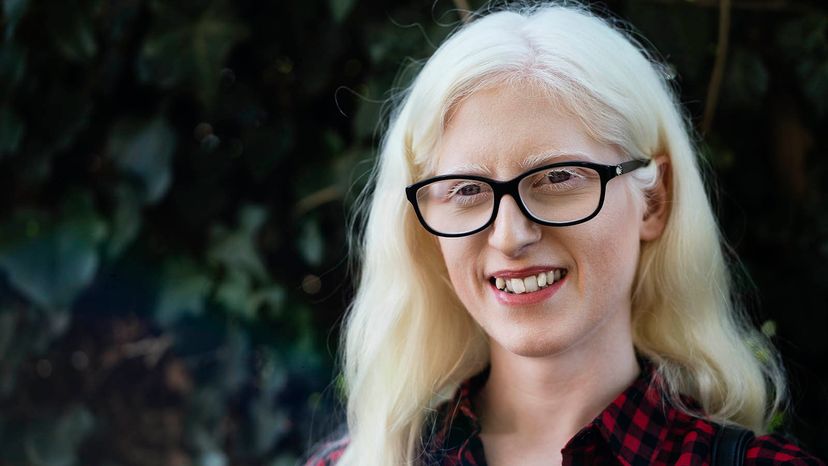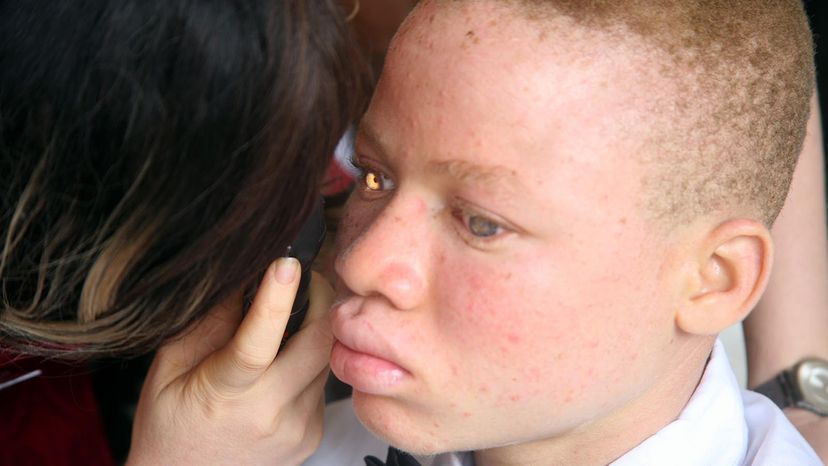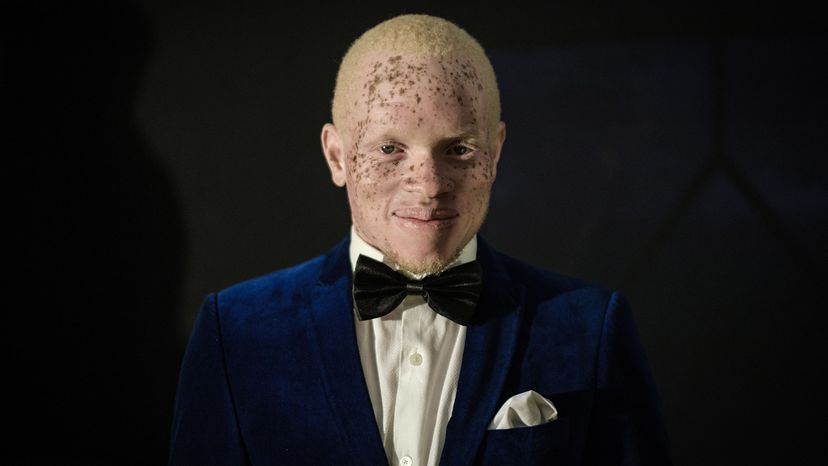
What, exactly, is albinism? Albinism is a collective term for many loosely related conditions. Everyone with albinism makes less than the normal amount of the skin pigment melanin. In order to understand how albinism works, you must first understand how melanin works.
We make melanin in specialized cells. Melanin colors our eyes, skin and hair. Since it can absorb every wavelength of light, melanin protects our skin from damage by the sun's ultraviolet rays. It also helps our eyes develop and handle visible light properly. In those with albinism, the amount of melanin made ranges from none to almost the normal amount. This can affect appearance — without melanin, hair and skin are both white. However, a person with slightly reduced melanin may look just like his unaffected parents and siblings [source: Oetting]. Doctors often diagnose albinism using an eye exam. Since melanin plays a part in eye development, people with albinism universally have unusual eye anatomy and less-than-perfect vision. Albinism isn't contagious, so you can't catch it. It's caused by a mutation in DNA, passed from parents to child, present at birth. In albinism, the mutation can happen in three areas:
Advertisement
- The recipe for melanin
- The proteins that make melanin
- The parts of the cell that package and distribute melanin
Albinism has been documented around the globe, in many ethnic groups [source: Roy]. Yet, it is rare. In the U.S., approximately one in 18,000 to 20,000 people has some type of albinism. In other parts of the world, the occurrence can be as high as one in 3,000 [source: NOAH]. Certain forms are more common in certain populations.

Melanin Production in Cells
Albinism is so much more than pale skin, hair and eyes. But what is the cellular recipe for melanin that goes awry in people with albinism?
If you stood at the shoulder of a doctor examining someone with albinism, you'd find that most everything — the brain (except for vision centers), heart, lungs, digestive system, muscles and immune system — looks healthy. Lifespan, except in untreated skin cancer, is unchanged. Intelligence is also unaffected.
That said, you might think of albinism as a manufacturing problem. The problem starts in the melanocytes, cells located in throughout the body, including:
- the bottom layer of the skin's epidermis
- the uvea, the area of the eye containing the iris and other nearby tissues
- the inner ear
- the leptomeninges, a membrane around the brain and spinal cord
- hair follicles
Melanocytes also manufacture melanin. Manufacturing begins when melanocytes, following instructions in DNA, construct melanin-making enzymes and the amino acid tyrosine. Production happens inside sacs called melanosomes. Melanosomes take in the enzymes and tyrosine. Inside melanosomes, the enzymes, acting as catalysts within the cells, begin a long series of chemical reactions in order to convert tyrosine into the two types of melanin humans have: eumelanin, which is brown or black, and pheomelanin, which is red or yellow.
Once melanosomes are packed with melanin, melanocytes ship it away to keratinocytes, barrier cells in the topmost layer of the skin and the iris in the eye, and to our hair. How much melanin is shipped, and the mix of pigments carried, determine our baseline skin, eye and hair colors. When melanocytes in the hair follicles don't make enough melanin, hair color can range from white, to yellow, to brown.
As the sun beats down on our skin, cells work to protect it from the heat and from harmful ultraviolet rays. Inside the keratinocytes, melanosomes respond to this assault in a curious way: They cover the nucleus like a beach umbrella, protecting the DNA. Ultraviolet rays can damage DNA and other cell parts, but melanin absorbs the rays. For people with albinism, there are not enough melanosomes available in skin cells to fight off the harmful rays. The resulting lack of melanin leaves the skin vulnerable to sun damage, increasing the risk of sunburn and skin cancer.

Albinism and the Eyes
We mentioned earlier that people with albinism often have imperfect vision. In albinism, the eye produces too little melanin during development. This causes parts of the eye to form abnormally, compromising vision.
Here's what happens: The iris, or colored ring in our eye, opens and closes the pupil. The retina, or screen in the back of the eye, collects the picture. Normally, melanin darkens both parts, allowing the iris to block light and the retina to absorb it. In albinism, the iris lets light through, and the retina poorly absorbs it. Light scatters in the eye, causing photophobia, an uncomfortable or painful sensation in bright light.
Albinism affects one's ability to see images as well as one's sensitivity to light. Our fovea, a pit in the center of the retina, is packed with millions of cones that provide color sensitivity to the eye. We need cones to see details clearly when reading, recognizing a face or watching television. During development, melanin helps our fovea form properly, but its exact role is unknown. In albinism, the pit may not form, and the area may have too few cones [source: Kelly]. Print may blur, and the eyes, continuously seeking a clear picture, may make involuntary motions — a condition called nystagmus. The head may wobble to compensate.
Albinism also affects the optic nerves. Our optic nerves connect our eyes to our brain. In embryonic development, melanin tells growing nerves exactly where to go in the eye. The nerves, directed by melanin, pass through an integration center on each side of the brain. Half cross — left eye to right brain — while half go to the center on the same side of the brain. This gives each center input from both eyes. The brain then overlays the two eyes' images, making a 3D picture. In people with albinism, there is a shortage (or complete lack) of melanin production, and the directions go astray. As a result, almost all of the optic nerves cross. The pictures seen by the two eyes are never combined. The brain quickly adapts, leaving a single picture but some trouble seeing depth. In addition to nystagmus, some people with albinism have strabismus, where one eye appears to move independently of the other. It's related to misrouted optic nerves [source: King et al].
Our eye's surface must be curved properly for sharp focusing. In albinism, errors in eye development may cause the cornea to curve irregularly, causing nearsightedness, farsightedness or a distorted image, called astigmatism. The lens may focus light unevenly on the retina, also causing astigmatism. Without correction, people with albinism see in the range of 20/60 to 20/400, which in the United States is considered legally blind [source: Gronskov].

Can You Detect Albinism?
Most cases of albinism are diagnosed in newborns. Doctors look for light hair and skin compared to unaffected siblings, parents and a person's ethnic group. Of course, many people have these traits. Doctors confirm with an eye exam, looking for a translucent iris and retina, vision in the albinism range, and other eye abnormalities. In milder forms of albinism, the eye looks virtually normal. Doctors may order a DNA test for albinism mutations [source: Gronskov].
In addition to albinism itself, doctors can also test for other conditions that list albinism as a side effect. These conditions include:
- Hermansky-Pudlak syndrome, in which albinism occurs with a bleeding, immune and tissue disorder
- Chediak-Higashi syndrome, in which albinism occurs with a blood cell, immune, and neurological disorder
- Prader-Willi and Angelman syndromes, in which albinism occasionally occurs with mental disability
Babies can be diagnosed before birth if a couple has had a child with albinism and doctors know which mutations have caused it. Doctors remove cells from the placenta, called chorionic villi sampling, at 10 to 12 weeks of pregnancy to test DNA. Later on in the pregnancy, doctors can test DNA by removing cells from the amniotic fluid, a procedure known as amniocentesis [source: Gronskov].
Oculocutaneous albinism (OCA) affects skin and hair color. Ocular albinism (OA) affects vision. Each has types, defined by which gene has mutated, and subtypes — and there are hundreds — defined by the exact mutation. New mutations continue to be found.
Treatments for Albinism
To date, there's no way to supplement melanin in people with albinism or to force the body to make it. Skin can't be darkened, and eye anatomy can't be fully corrected. But hope is not lost. Treatments for albinism complications are readily available.
Early visits to low-vision eye specialists can improve vision dramatically. Here's what they might prescribe:
- Glassesorcontact lenses help sharpen vision by correcting nearsightedness, farsightedness and astigmatism.
- Sunglasses counteract annoying photophobia, both indoors and out. Glasses that block all ultraviolet rays additionally protect the retinas from sun damage.
- Used early, eye patches can treat strabismus by strengthening a wayward-moving eye. Eye-muscle surgery is an alternative.
- Vision aids, such as large-print books, computer displays and video magnifiers, enhance details. Telescopic lenses called bioptics allow focusing close up and far away. Speech synthesizers can help with reading.
Many everyday tricks also help with vision. A finger placed by the eye or head tilting can reduce twitchy nystagmus during reading. To better read small print or watch television, people with severe farsightedness may sit inches away from the book or TV. Unfortunately, perfect vision can't be restored because current treatments can't correct the optic nerve routing problem or the underdeveloped fovea [source: Oetting].
It is imperative that people with albinism protect their skin from the sun. Protection doesn't necessarily mean staying inside in the dark. Beach vacations are possible, with precautions. The best protection is a plan for managing sun exposure.
Giovanna Ciocca, M.D., of the Children's Skin Center at Miami Children's Hospital, recommends staying out of the sun between 10 a.m. and 4 p.m. and being careful in snow and sand, which reflect rays. She recommends sunscreen — SPF 30, with protection against UVA and UVB rays — on all exposed body parts. It should be applied 30 minutes before going outside, applied amply and reapplied often. The best sun-blocking clothes are densely woven, breathable synthetic fabrics and a wide-brimmed hat. People with albinism can sunburn on cloudy days because UV rays permeate clouds, Ciocca says.
Without protection, people with albinism will develop skin damage and skin cancer. Dark spots may appear that look like freckles. They're not freckles or spots of melanin, explains William Oetting, a professor at the University of Minnesota who has researched albinism genetics. In fact, they're discolorations where proteins and fats inside cells have been destroyed. Skin may also become leathery over time as UV rays age the cells [source: Mayo Clinic]. Skin cancer is avoidable with lifelong protection against UV rays. If caught early, most cases are treatable and curable [source: King et al]. In sub-Saharan Africa, where sun protection can be expensive and treatment isn't always available, skin cancer rates among people with albinism are high [sources: Adegbidi and Dickinson].

Life with Albinism
Most children with albinism can attend mainstream schools. Parents should contact the school system before kindergarten to plan for their child. Classroom accommodations include video magnifiers, large-print textbooks, audio tapes to supplement reading, large-print copies of board notes, and use of computers for writing projects [source: International Albinism Center].
Despite these gestures, people with albinism still face teasing, stares, well-meaning but ignorant questions, feelings of otherness and isolation, and myths about the condition [source: NOAH]. Parents should equip children early to cope, recommends June Waugh, a child and family counselor affiliated with the National Organization for Albinism and Hypopigmentation (NOAH). Strategies include discussing albinism and a child's feelings, developing a positive attitude toward albinism, practicing responses to bullies, and meeting others with albinism.
Once you have made friends with people with albinism, you may wonder if it's OK to call your new pals "albino" or "albino people". Many people with albinism don't think so, seeing themselves as a people first, not a condition, and preferring "person with albinism."
Despite vision impairment in those with albinism, playing sports rarely becomes an issue. "The 'can't do' list is small ... squash, tennis. badminton," writes Martin Lang, a member of the Albinism Fellowship, about sports for his 10-year-old daughter with albinism [source: Lang]. Sports with small balls can be difficult for people with albinism, but these can be adapted using sound [source: Winnick].
Depending on vision, preference and local laws, people with albinism can drive under certain road conditions, with the use of bioptics. Poor vision can limit careers for people with albinism, but most limits can be overcome with technology, adaptation and determination. People with albinism become doctors, athletes and artists [source: NOAH].
In other places, however, people with albinism have more serious problems. In some parts of Africa, lack of classroom accommodations and stigma can prevent people with albinism from holding profitable jobs [source: Machipisa]. Even worse for Africans with albinism, dangerous myths are circulating in Kenya, Tanzania, Zimbabwe and other countries that perpetuate the raping, killing and dismemberment of people with albinism. These include that body parts of people with albinism carry good luck and that intercourse with a woman who has albinism can cure HIV [sources: Gettleman and Machipisa]. Governments and local support groups are working on education and protection campaigns.

Albinism in Animals
The occurrence of albinism runs the gamut across the animal kingdom. According to the Missouri Conservationist, published by the Missouri Department of Conservation, at least 300 species in North America have had at least one reported instance of albinism. Researchers observe albinism occurs once out of every 10,000 mammal births. Albinism is much more common in birds, occurring once in every 1,764 births. Diluting or spreading out a species' gene pool greatly reduces the chance of albinism [source: Miller].
Such animals fare poorly in the wild, says Chad Staples, a curator at Featherdale Wildlife Park in Doonside, Australia. "Their rate of survival is virtually zero," says Staples. "Predators easily pick them out of a group. Families and social groups can exclude them because to every other member, they look foreign."
In captivity, albino animals fare better. At Featherdale, albino wallabies are trained to stay in the shade, and the hypopigmented blue-tongued lizard (which loses skin color over time) soaks up necessary UV rays with special modulation to reduce cancer risk. When it comes to mating, some species fare better than others. The albino peacock attracts females just fine, but suitors shun the albino kookaburra, Staples says.
Albino animals make prized — and pricey — pets. Albino lab animals, like the BALB/c mouse are inbred to make litters genetically similar; albinism is a side effect [source: Faletra]. These animals were also prized as laboratory research subjects, although that assessment has come under fire lately due to their rarity and genetic mutation and is now considered inappropriate by some [source: Leathers]. However, they continue to be cherished in the wild. In some areas of Missouri, white squirrels with partial albinism have become quite popular with locals who pamper them and protect them from hunters and other predators [source: Miller].
Advertisement
